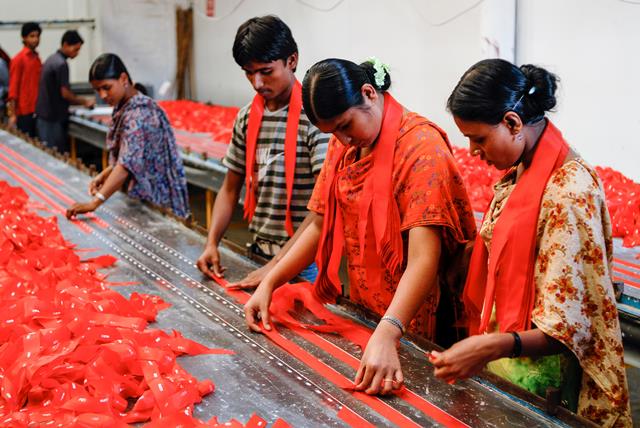 Dhaka, Bangladesh: work at a textile factory producing clothing for export. [photo: Joerg Boethling / Alamy]
Dhaka, Bangladesh: work at a textile factory producing clothing for export. [photo: Joerg Boethling / Alamy]
[This is an excerpt from an article in The Round Table: The Commonwealth Journal of International Affairs.]
Every year, more than 400,000 low-income individuals migrate to Dhaka, contributing to the city’s increasing housing and service requirements. This significant influx comprises both job seekers and victims of disasters, leading to unplanned urbanisation throughout the metropolis. As a result of this population boom, many illegal slums and squatter colonies have emerged. According to the International Organization for Migration (IOM), 70% of Dhaka’s slum inhabitants face environmental challenges (McPherson, Citation2015). The most recent census indicates that 0.88 million Dhaka residents and 1.8 million people nationwide live in slums (BBS, Citation2022). The majority of city dwellers come from impoverished backgrounds, and the strain on land, water, and other resources is evident, contributing to the rise in urban poverty. Lacking resources and income, many of them inhabit hazardous marshes and lakes, primarily belonging to the minority and disadvantaged sections of society. These marginalised individuals encounter challenges and are more susceptible to social conflicts (Baird, Citation2008).
A survey conducted in the Bhola slum of Dhaka by Schwerdtle et al. (Citation2021) highlights the challenges migrants face, including scarcity of fresh water, inadequate sanitation, and limited healthcare facilities. These migrants find themselves ‘trapped at the destination’, lacking the resources and assets required for relocation. They face risks at both their origin and destination, encountering hazards and vulnerabilities, especially in their new surroundings (McNamara & Rahman, Citation2016). Despite the pressing need for continuous adaptation to reduce climate-related health risks, Bangladeshi urban authorities struggle to provide sufficient housing and environmental services to climate migrants. Local officials often view slum dwellers as illegal squatters rather than residents entitled to essential services, afraid that providing facilities might lead to claims for permanent residency (McDonnell, Citation2019). A survey in Korail, one of Dhaka’s largest slums, indicates that local slum dwellers are reluctant to assist climate migrants and Rohingya refugees but express willingness to help those relocating for economic and educational opportunities (Castellano et al., Citation2021).
Migration from Bangladesh: Impulses, Risks and Exploitations
Return of the slave market
The scarcity of vital resources, such as clean drinking water, electricity and sanitation facilities, frequently precipitates social unrest and conflict (Brzoska & Fröhlich, Citation2016; Huq et al., Citation2003). The situation escalates when the densely populated city grapples with crises such as floods, waterlogging, and riverbank erosion. Approximately half the population of Dhaka resides in low-lying districts bordered by water bodies like the Buriganga River and the Balu River is particularly susceptible to flooding. Insufficient infrastructure post-disasters contribute to unsanitary environments, leading to waterborne infections (Saha et al., Citation2019). Women, in particular, face heightened vulnerability to exploitation and abusive practices, enduring issues related to land tenure and shelter insecurity.
Gender aspect of climate migrants
Various environmental crises impact both men and women, but socio-cultural norms and historical practices embedded in society’s power structure influence distinct roles that shape their consequences (Björnberg & Hansson, Citation2013; Tschakert & Machado, Citation2012, p. 276). Despite numerous studies on internal migration in Bangladesh triggered by climate disasters, few delve into the gender-specific roles and responsibilities of men and women in response to such migrations (Sams, Citation2019, p. 58).
Women face unequal access to natural resources, productive assets, and technical information, limiting their decision-making capacity regarding migration and other forms of mobility. Women’s migration extends beyond the physical relocation, encompassing social and psychological issues (Kronlid & Grandin, Citation2014; Lama, Citation2018). These women in urban centres face social vulnerabilities as they navigate the clash between urban norms and their traditional values. In patriarchal societies, where only men relocate for work, women endure additional challenges, balancing external employment with domestic responsibilities due to financial pressures (Ahmed & Eklund, Citation2021; M. G. Rabbani et al., Citation2015).
Research by Neumayer and Plümper (Citation2007) reveals that women are more vulnerable during natural disasters, particularly in societies where the socio-economic status of women is low. Timely access to early warning information is crucial during such events, yet women in rural areas often lack mobility in places where information is distributed, resulting in delayed or no receipt of critical information (Ahmed & Eklund, Citation2021; Reggers Citation2019, p. 107). The social construction of gendered inequality also contributes to women’s heightened exposure to injury and death during disasters (Juran & Trivedi, Citation2015). Dewan (Citation2023) argues that climate-reductive migratory translations obscure the affective relationships that support agrarian livelihoods. The migration choices made by landless single mothers residing in coastal regions are mainly influenced by the means of sustenance provided to their children.
Many female migrants in Dhaka find employment in the garment manufacturing industry, where wages notably surpass those in traditional domestic labour. Factory owners prefer employing women, perceiving them as simple to manage. Due to societal expectations and power dynamics, women in this sector are less likely to voice concerns about adverse working conditions or inadequate compensation, perpetuating this cycle of oppression (Evertsen & van der Geest, Citation2020, p. 17). Similar challenges confront tea plantation workers who grapple with low pay, long hours, unhealthy living conditions, and the looming fear of punishment. The situation has deteriorated further in the post-Covid-19 era. Given that a majority of tea leaf pickers are women, gender-based discrimination further compounds their struggles (M. N. Islam & Al-Amin, Citation2019; Ullah & Chowdhury, Citation2022).
Reports from IIED on the link between climate-induced migration and modern slavery indicate that traffickers target Bangladeshis who migrate to India for work after floods and cyclones devastate their farmland (Bharadwaj et al., Citation2021).
Priyanka Mallick is an Assistant Professor, Department of Political Science, Mount Carmel College, Bangalore, India.



